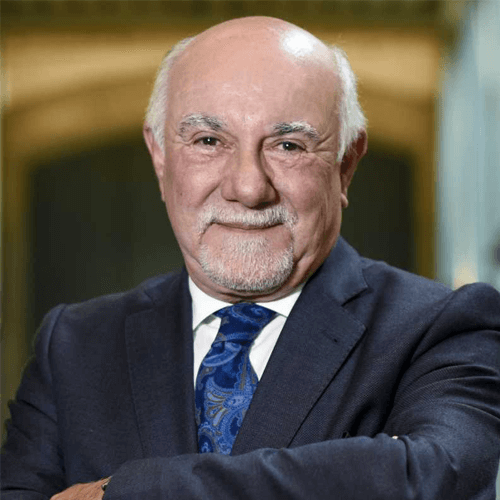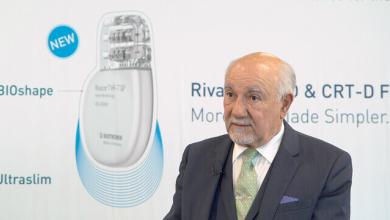
Research areas
Biography
Personal History
Pedro Brugada Terradellas was born in Girona, Spain on August 11, 1952. Although his parents were both farmers with no connection to medicine, he, along with two of his three siblings, went on to study medicine in Barcelona and specialise in cardiology.1
During his studies, he initially intended to specialise in haematology, but following the birth of his daughter at age 22, he accepted a position in cardiology and completed his training at the age of 26.2, 7
Dr Brugada is known for his discovery of Brugada Syndrome, which was named after him.1 In 2004, he installed an automatic defibrillator in the chest of football player Khalilou Fadiga after he collapsed during the warm-up to a match.3 He is a highly experienced lecturer and has said that the speech that affected him the most was the one he gave at his village cemetery when his father died in 1999.7
Dr Brugada lives in Belgium and is married to Kristien Van Caelenberg, a cardiovascular intensive care nurse, together they have five children.1, 5 Outside of work, he enjoys spending time with his family and friends. His interests include history, music, sailing, painting, classic cars and golf.2
Academic History
After high school in Girona, Dr Brugada enrolled in the Faculty of Medicine of the University of Barcelona in 1969 and graduated in 1975. He worked as an intern at the Hospital Clínico de Barcelona and obtained a temporary position in the Hospital of Sant Pau i Santa Tecla in Tarragona.
After completing his cardiology training, he moved to the newly-established Maastricht University for a six-month fellowship. He was accepted by Professor Hein Wellens, who was the new Professor and Chairman of the Department of Cardiology, at Maastricht’s Academic Hospital.
His academic research led to the discovery of the heart disease known as Brugada Syndrome; a genetic defect that causes cardiac arrest and arrhythmias.4 It was first uncovered when Dr Brugada and his brothers observed an unusual pattern in the electrocardiogram readings of patients who had died suddenly.6
Most of his research activity was initially focused on understanding the cause of arrhythmias, but after discovering Brugada Syndrome in 1986 this became his main area of focus. Dr Brugada is also fascinated by classic electrophysiology mechanisms. More recently, he has been looking at the application of artificial intelligence in rhythmology, the circulatory system of the drosophila fly and all applications of hybrid surgery in the treatment of cardiac arrhythmias.2
Career Overview
Dr Brugada was a General Practitioner in the Pyrenees and then practitioner of Internal Medicine in Tarragona. After his time in Tarragona, he joined the emergency services of the Social Security in Barcelona, followed by a residency at the Clinical Hospital.
In 1979, Dr Brugada moved to the Netherlands as a researcher at the Cardiac Electrophysiology Clinic of the Maastricht University to train in Clinical Cardiac Electrophysiology alongside Professor Hein Wellens.1 He became a teacher and lived there for twelve years. In 1982, he presented his doctoral thesis at Maastricht University, where he was granted the position of Director of the Clinical Electrophysiology Laboratory and, later, Professor of Cardiology.5
In 1990, he moved to Aalst in Belgium to create the first arrhythmia unit in the country at the Department of Cardiology of the OLV hospital directed by Dr Eric Andries. After 17 years of successful clinical work and research, he moved to the University Hospital of Brussels to develop an international Heart Rhythm Management Centre. He was then appointed Chairman of the Cardiovascular Division until 2017 and is now the Scientific Director of the Cardiovascular Division.
Dr Brugada was President of the Spanish Society of Cardiology, a member of the American Heart Association, the European Society of Cardiology and the Belgian Society of Cardiology, among many others.6 He was also appointed an honorary member of the College of Physicists of Girona and entered the Royal Academy of Medicine of Seville as an honorary academic in 2017.6
He has been widely published, covering over 1,000 scientific papers in some of the most prestigious scientific journals of the field, including Revista Española de Cardiología, Europace and Circulation.5 He is the Head of Heart Rhythm Management Centre at Universitair Ziekenhuis Brussels (UZ Brussel) and a professor of Onze Lieve Vrouw Ziekenhuis Aalst, Belgium.
Career Timeline2
- 1969 - 1975: Medical School, University of Barcelona School of Medicine, Barcelona, Spain
- 1976 - 1979: Resident, Cardiology
- 1979 - 1980: Research Fellow, Clinical Cardiac Electrophysiology, University of Limburg, Maastricht
- 1980 - 1984: Assistant Professor, Department of Cardiology, University of Limburg, Maastricht
- 1982 - 1990: Director, Clinical Electrophysiology Laboratory, University of Limburg. Maastricht
- 1988 - 1990: Head, Division Coronary Disease, Institute for Cardiovascular Diseases, University of Limburg, Maastricht
- 2009 - 2011: Chair, Fellowship Committee European Heart Rhythm Association
- 2011 - 2016: Chair, Cardiovascular Division, UZ Brussel
- 2016 - 2017: Scientific Director, Arrhythmia Unit, GVM Italy
- Present: Head, Heart Rhythm Management Centre, UZ Brussel
- Present: Scientific Director, Cardiovascular Division, University Hospital UZ Brussel
- Present: Chief Executive Officer, Medisch Centrum Prof P Brugada, Aalst, Belgium
- Present: Director, Arrhythmia Unit Hospiten, Estepona, Spain
Recognition2
- 1999: Fritz-Acker Stiftung Award, German Society of Cardiology
- 2001: Cardiologist of the Year 2001, Paris, France
- 2003: First Prize at the European Society of Cardiology, Vienna, Austria
- 2008: Mirowski Award, San Francisco, USA
- 2009: Einthoven Gold Medal, European Heart Rhythm Association
- 2012: Gold Medal, European Society of Cardiology
- 2012: Ebony Spoor in the Flemish Parliament8
- 2017: Honorary Lecture FAFA. Frankfurt, Germany
- 2019: Grand Prix Scientifique 2019, Institut de France, Fondation Lefoulon-Delalande
- Andrés Bello Order of Venezuela
- Medalla Josep Trueta of the Catalan Government
- Honorary Great Civil Medal from the Flemish Government
- Golden Spoon for Social Appearance
Areas of Speciality5
- Brugada Syndrome
- Atrial Arrhythmias
Sources
https://www.biografiasyvidas.com/biografia/b/brugada.htm
https://cardiacrhythmnews.com/pedro-brugada/
https://www.eurosport.com/football/premiership/2004-2005/fadiga-to-battle-the-pain_sto653539/story.shtml
https://hospiten.com/noticias/post/7507/el-dr-pedro-brugada-recibe-el-gran-premio-cient%C3%ADfico-del-instituto-de-francia
https://academic.oup.com/eurheartj/article/41/10/1073/5788558
https://fundacionfic.es/noticias/pedro-brugada-en-el-hospital-clinico-san-carlos/
https://healthmanagement.org/c/cardio/issuearticle/interview-with-prof-p-brugada
https://www.gva.be/cnt/aid1109725
Dr Brugada is on the AER Editorial Board.
Media
Articles by Pedro Brugada, Head of Heart Rhythm Management Centre
Vincent Umbrain, Christian Verborgh, Gian-Battista Chierchia, et al
Citation: Arrhythmia & Electrophysiology Review 2017;6(4):210–6.
Giulio Conte, Maria Luce Caputo, François Regoli, et al
Citation: Arrhythmia & Electrophysiology Review2016;5(2):84–9
Juan Sieira, Pedro Brugada,
Citation: Arrhythmia & Electrophysiology Review 2016;5(3):164–9











